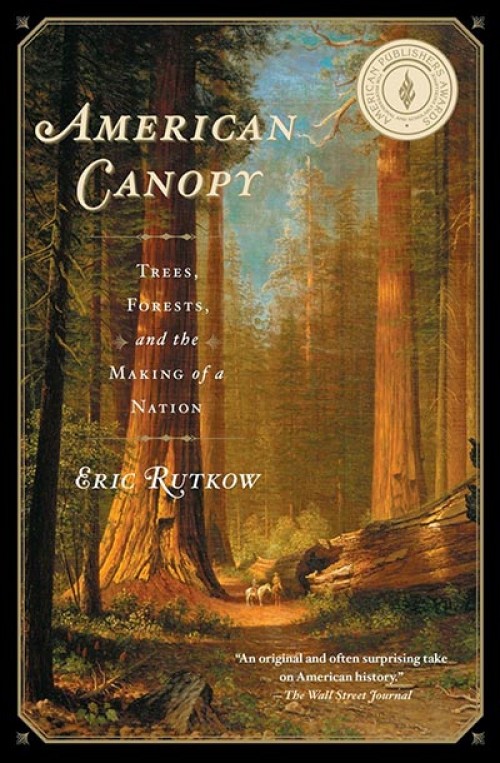by Eric Rutkow
Scribner, 2012
Ever since the deserved success of Mark Kurlansky’s Cod: A Biography of the Fish That Changed the World, readers have faced an avalanche of titles seeking to show how a seemingly banal commodity — salt, spices, potatoes, bananas, oysters, sugar, rum, cotton and, yes, white bread — profoundly shaped America or the world. These biographies of the inanimate allow us to examine history from a refreshing vantage point, from which we might see important things in our past we’d missed before.
Eric Rutkow’s American Canopy is a case in point. It explores how trees have shaped American identity and how Americans have reshaped the continent’s forests. Rutkow makes some hyperbolic assertions at the outset – that “nowhere else has the culture been so intimately associated with wood” (what of Russia, Finland, and Canada?) and that trees shaped America more than other nations (even Brazil and Central America’s banana republics?) – but the general arguments are sound and enlightening. Our country and national character were profoundly shaped by the presence of an immense and seemingly inexhaustible supply of trees, and our changing attitudes toward trees and forest reflect our no-longer-young society’s gradual acceptance of limits.
For most seventeenth century Europeans, wood was an expensive and often scarce resource. The English filled in their buildings’ wooden frames with plaster, stone, thatch and other materials, and sourced their warships’ masts and other components from the Baltic. Firewood had become so expensive that the poor could no longer afford winter heating.
By contrast, early colonists of our Eastern seaboard confronted seemingly unending forests, which hampered farming efforts and sheltered a frightening array of opponents, real and imagined. Rutkow shows how this surfeit of trees conditioned Americans to become heavy resource consumers, “always happy to save a day or a dollar by chopping down another trunk.” New Englanders could build English-style houses with wooden walls, clapboards, and shingles. Appalachian frontiersmen took a page from the Swedish playbook and built homes, barns, and even fences out of interlocking logs, a method that, in terms of board feet consumed, would have given an English baron pause back at home. Southern longleaf pines can be tapped for turpentine in ways that won’t kill the tree, but they were so common that settlers didn’t bother to make the extra effort. As late as 1840, 95 percent of the nation’s heating, lighting, and transport fuel came from trees.
Rutkow argues that this seemingly endless supply of building and energy materials engendered a throwaway culture. Things didn’t need to be built to last or even to be efficient. Fireplaces wasted 90 percent of heat, but fuel was so cheap that few had an incentive to buy one of Benjamin Franklin’s new metal woodstoves. As railroads expanded in the mid-19th century, they not only used wooden ties, trestles, and rolling stock; their locomotives were powered by dry pitch pine, producing what Charles Dickens once described as “a whirlwind of bright sparks, which showered about us [passengers] like a storm of fiery snow.” These wood demands prompted the stripping of timber along rail routes, and the locomotives’ dangerous exhaust created forest fires that wiped out thousands of acres at a time. Only once lumber titans, paper companies, and forest fires depleted the East’s mature forests did a conservation movement take form in the late 19th century. Appreciation of forests’ recreational and ecological functions took even longer.
But intellectual arguments aside, American Canopy is, at its core, a collection of tree tales, many of them wonderfully enjoyable. There’s the Horatio Alger story of teenage immigrant Frederick Weyerhaeuser, founder of the continent-spanning lumber company of the same name, who transformed the way timber was owned and harvested. There’s the unlikely story of the founding of Southern California’s orange industry, which relied on the chance importation of cuttings from a mutated Brazilian tree that produced seedless oranges.
Readers above a certain age will remember the tragic destruction of the stately elms that once wrapped our streetscapes in a sun-dappled canopy, but Rutkow also brings to life the chestnut blight epidemic that permanently diminished the commercial and ecological value of Eastern forests. We’re also reminded that protecting forests was, not that long ago, a matter of national security. In World War I, the military simply took control of the Pacific Northwest’s lumber sector to ensure the supply of Sitka spruce, then essential for the construction of military aircraft. Japanese planes, balloons, and submarine-based artillery tried to burn these same forests down in World War II, and Washington was so worried about accidental fires that it enlisted Madison Avenue to create a campaign that ultimately gave us Smokey the Bear. (The original tagline: “Careless Matches Aid the Axis.”)
These are vignettes well told, and readers will come away from this, Rutkow’s first book, with a greater appreciation of the role of both forests and trees in our ongoing national story.


